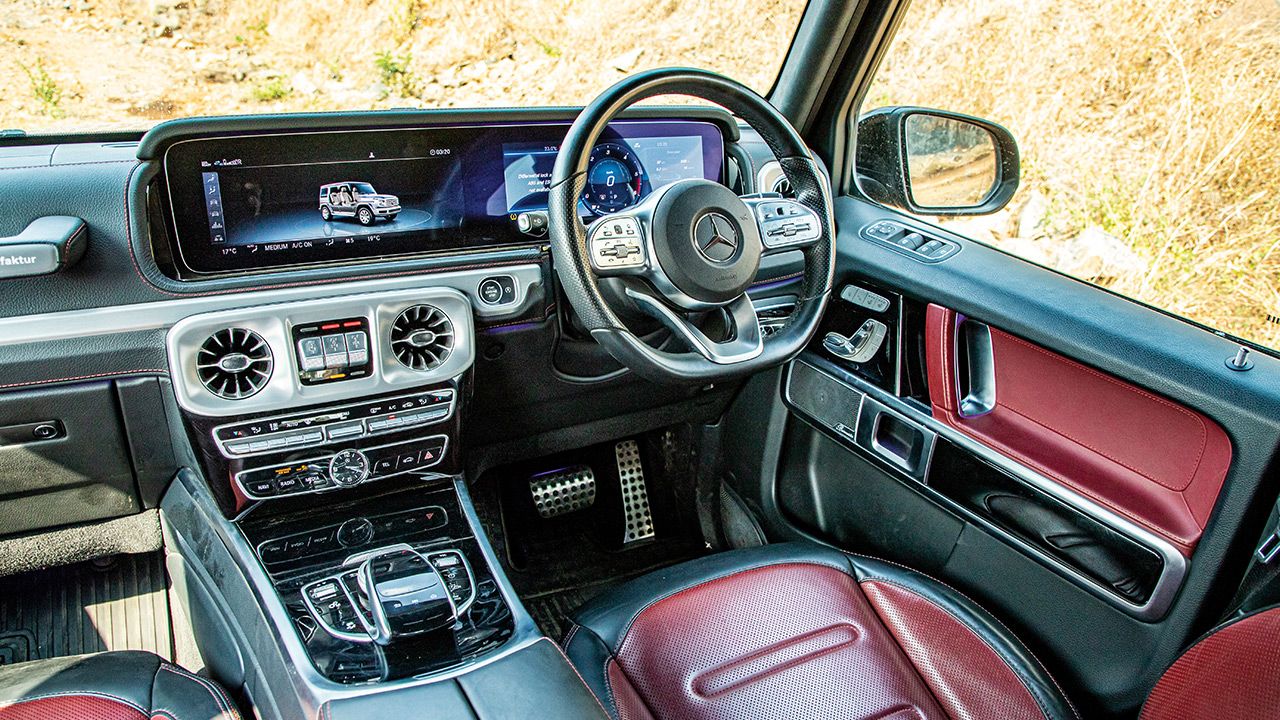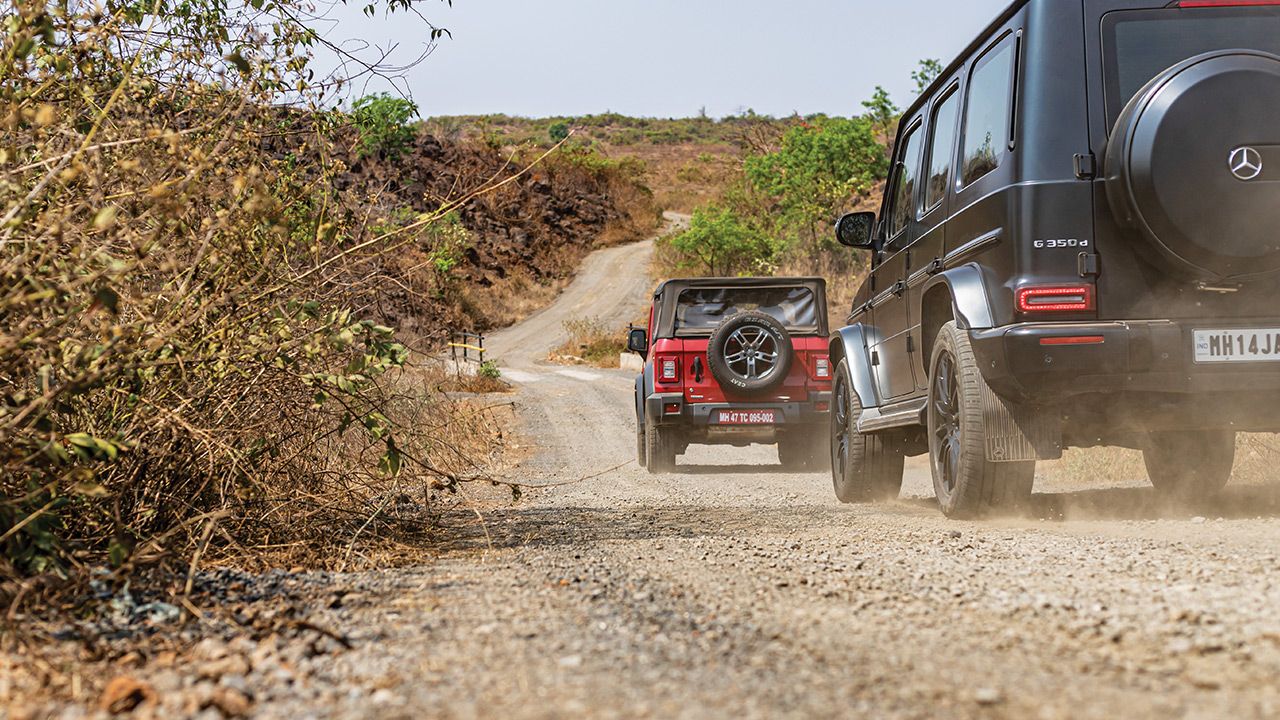Mahindra Thar & Mercedes-Benz G-Wagen: Feature
As automotive legends go, the Mercedes-Benz G-Wagen is a name that needs no introduction. On the other end of the spectrum, there is the Mahindra Thar. A legend in its own right, the Thar has an unparalleled cult following in India.

The Mahindra Thar and Mercedes G-Wagen are worlds apart – by a crore-and-a-half and then some – but there is a common thread between the two.
As automotive legends go, the Mercedes-Benz G-Wagen is a name that needs no introduction. Where do you start? Longest running production series name for Mercedes. Four decades of evolution. Brutal. Badass. Off-road hero. A status symbol, and what not! Stronger than time itself, the G-Wagen continues to blow our minds with its unapologetic ruthlessness till today. It would be fair to say that, money no object, the G-Wagen is the most badass and most desirable SUV currently on sale in the country, or even around the globe.
On the other end of the spectrum, there is the Mahindra Thar. A legend in its own right, the Thar has an unparalleled cult following in India. Sure, it may not have its name carved in stone as an outright automotive legend as yet, but given its popularity and how it tugs at the heartstrings of masses, it’ll end up being one soon. And, just like the G-Wagen, the Thar is the most badass, coolest and most desirable SUV on the market, but the crucial difference is that, unlike the big G, the Thar’s the most affordable true-blue off-roader that money can buy in India.

Now before you start hurling abuses at us for doing a senseless comparison between these two, hear me out. This isn’t an actual comparison test. Instead, our aim here is to see what makes these two badass SUVs at the extreme ends – which are connected by this common thread of old-school charm in the world of me-too SUVs – so desirable?
G for Gangsta
Time doesn’t stop for anyone, except the G-Wagen – and I’m not even kidding. The development of the original G-Wagen began in 1972 when Mercedes, in partnership with Austrian conglomerate Steyr-Daimler-Puch, decided to come up with a light off-road vehicle for military and civilian usage. However, it was only in 1979 when the production of the Geländewagen began at Magna Steyr's plant in Graz. The rest, as they say, is history. For over 40 years, the G-Wagen has stuck to its roots. However, from being a crude off-roader at the time of its inception, the G-Wagen has now transformed into a lustful item of luxury for influential men and women.

Despite its rudimentary origins, Mercedes has shipped over 400,000 G-Wagens and continues to do so, across the world. But it’s not just the old-world charm that’s driving the sales of the G-Wagen today. In 2018, Mercedes gave the G a thorough makeover – okay, it does carry forward the same gangsta look of the original, but the surfaces have been refined. Plus, inside the cabin, it’s every bit as modern as a GLS. And underneath, there’s more modern stuff – the independent double-wishbone suspension has replaced the solid axle in the front (the rear is still a solid axle though), the steering is electrically assisted, and while the ladder-frame remains, it’s been thoroughly re-engineered. But don’t think it’s gone soft. The G-Wagen still features three locking differentials and a low-range gearbox – it is hard-as-nails as ever.

What’s remarkable about the G-Wagen is its on-road behaviour – for something that has a centre of gravity of the Tower of Pisa, the G’s tight body controls leave you speechless every time you go around a corner. At the same time, it’s utterly refined and comfortable. Apart from its brick-like aerodynamics and the gratifying bolt-action rifle clack of doors locking/unlocking, there’s nothing ancient about the G-Wagen.
Take it off-road – if you dare to do that in a ₹2-crore car – and it’ll blow your mind further. With a ground clearance of 241mm, 30.9-degree approach angle, 29.9-degree departure angle, and 23.5-degree breakover angle, along with 700mm of water wading, there’s no incline too steep and no river too deep for the G. It’s as if the G-Wagen can flatten every surface, or make you feel like it’s doing that. And it does all that while cocooning you in luxury. This thing is like Buckingham Palace wrapped in a battle tank. Silly and rib-ticklingly enjoyable.

The G 350d that you see here has a creamy 3.0-litre six-cylinder diesel engine. With 600Nm and 282bhp, it has more-than-required grunt for all occasions. But I somehow feel it lacks soul. It’s not as insane as the rest of the car. And that’s why I prefer the G63’s AMG V8 motor over it. Yes, it’s thirsty, but it does the G-Wagen more justice. And why do you even need a sensible and frugal diesel in a mad car like the G-Wagen? It’s like going to a Michelin 3-star restaurant and sticking to soups and boiled veggies because it’s good for digestion. Why not go get the full deal?

Rough-and-ready
The Thar may not have an illustrious history as the G-Wagen, but to reach where it is today, it has gone through a long and rather glorious journey. Although the Thar was first introduced in 2010, its legacy harks back to 1949 when Mahindra began producing Willys CJ3A ‘Jeep’ in India. It was the company’s first-ever off-roader. Over decades, Mahindra built its reputation as a proper SUV manufacturer with iconic off-roaders like the MM540, MM550, Classic, Legend, et al. And even though the current second-gen Thar, or the original for that matter, can be called as a modern interpretation of the MM540 from the 90’s, it’s leaps and bounds ahead in every way. In fact, the new Thar is a remarkable product. That’s because it’s been thoroughly refined in its latest avatar, but it hasn’t lost the old-world charm or essence of its forefathers.
Look at its design. While the old Thar looked crude and battle-ready, the new one looks sophisticated and aggressive at the same time. And the proportions are just right – short wheelbase, short overhangs, beefy stance and tasty 18-inch alloy wheels. Even when you park it next to something as iconic as the G-Wagen, it won’t be dwarfed. Yes, the G has a more alluring badge, but the Thar has its own swagger too. It’s fair to say that the Thar is a brand in itself now.

Step inside, and it doesn’t look as utilitarian as before. Sure, there are hard plastics all around and there are some surfaces that are still rough, but it’s easily liveable on a day-to-day basis. It no longer feels like a medieval cave inside – there’s a nice touchscreen, Apple CarPlay and Android Auto, cruise control, and more creature comforts. Even the upholstery and overall design and layout of the dashboard have a modern and up-to-date feel. Of course, it’s the not most premium cabin at its price point, but given its off-road pedigree and the cool factor, I can live with its foibles without caring much.
What’s more, it’s much nicer to drive than before. The ride is better and the engine options are impressive. My favourite of the bunch is the petrol AT, which is also what we had on test. In everyday driving, the combination is supremely refined, quick and offers ample performance, while off-road, it offers nearly as much grunt as the diesel. Things which aren’t so good – well, the ride is better but it’s still very bumpy. Plus, with 150bhp and 320Nm on tap, the engine simply overpowers the chassis, suspension and brakes when you go over 100km/h. However, when the going gets rough, it’s a totally different story…

The Thar packs some serious off-road kit. Four-wheel drive, mechanically-locking rear differential, low-ratio transfer case, brake locking differential, and AT tyres – everything is bog-standard in the Thar. Plus, with approach, ramp over, and departure angles of 41.8-degree, 27-degree, 36.8-degree, respectively, the Thar is an unstoppable force. Forget casual drivers, even seasoned off-roaders will find it more than just capable for mud-plugging or dune-bashing duties. What I really love about the Thar is this indestructible feel that you get while driving it. Abuse it all day and it’ll reward you even more.
After spending so much time with the G-Wagen and the Thar, I had a silly grin on my face. But more importantly, I could also see a similar personality pattern with these two. They may be poles apart in terms of their price and positioning, but they follow similar philosophies in life. They both like to swim against the tide, they’re being unapologetically themselves, and they’re cool and badass at the same time. Logically, there’s no place for a G-Wagen over a GLS, or a Thar over a Creta, in your garage. And yet you see people fall head over heels in love with these two without any regrets. Living legends for sure.

Read more:
Mahindra Thar Petrol AT Off-Road Review
Budget off-roading: New Mahindra Thar Petrol AT vs Hero Xpulse 200
Engine: 2,925cc / Inline 6-Cylinder / Turbocharged
Fuel: Diesel
Transmission: 9-Speed Automatic / Four-Wheel Drive
Power: 282bhp @ 3,400 - 4,600rpm
Torque: 600Nm @ 1,200 - 3,200rpm
Price: ₹1.62 Crore (Ex-showroom)
X-factor: Timeless, borderline bonkers, unbelievably good to drive & a textbook example in badassery.
|
Pros |
Cons |















Write your Comment on